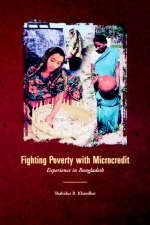
FIGHTING POVERTY WITH MICROCREDIT EXPERIENCE IN BA
Seiten
1998
Oxford University Press Inc (Verlag)
978-0-19-521121-4 (ISBN)
Oxford University Press Inc (Verlag)
978-0-19-521121-4 (ISBN)
- Titel z.Zt. nicht lieferbar
- Versandkostenfrei
- Auch auf Rechnung
- Artikel merken
This text examines the experiences of the Grameen Bank and two other major microcredit programmes in Bangladesh in order to quantify the potential and limitations of microcredit programmes as an instrument for reducing poverty and delivering financial sevices to the poor.
Providing the poor with access to financial services is one of many ways to help increase their incomes and productivity. In many countries, however, traditional financial institutions have failed to provide this service. Microcredit and co-operative programmes have been developed to fill this gap. Their purpose is to help the poor become self-employed and thus escape poverty. Many of these programmes provide credit using social mechanisms, such as group-based lending, to reach the poor and other clients, including women, who lack access to formal financial institutions. With increasing assistance from the World Bank and other donors, microfinance is emerging as an instrument for reducing poverty and improving the poor's access to financial services in low-income countries. This book examines the experiences of the Grameen Bank and two other major microcredit programmes in Bangladesh in order to quantify the potential and limitations of microcredit programs as an instrument for reducing poverty and delivering financial sevices to the poor.
Providing the poor with access to financial services is one of many ways to help increase their incomes and productivity. In many countries, however, traditional financial institutions have failed to provide this service. Microcredit and co-operative programmes have been developed to fill this gap. Their purpose is to help the poor become self-employed and thus escape poverty. Many of these programmes provide credit using social mechanisms, such as group-based lending, to reach the poor and other clients, including women, who lack access to formal financial institutions. With increasing assistance from the World Bank and other donors, microfinance is emerging as an instrument for reducing poverty and improving the poor's access to financial services in low-income countries. This book examines the experiences of the Grameen Bank and two other major microcredit programmes in Bangladesh in order to quantify the potential and limitations of microcredit programs as an instrument for reducing poverty and delivering financial sevices to the poor.
| Erscheint lt. Verlag | 17.12.1998 |
|---|---|
| Zusatzinfo | tables |
| Verlagsort | New York |
| Sprache | englisch |
| Maße | 152 x 229 mm |
| Gewicht | 1250 g |
| Themenwelt | Sozialwissenschaften ► Politik / Verwaltung ► Staat / Verwaltung |
| Sozialwissenschaften ► Soziologie ► Spezielle Soziologien | |
| Betriebswirtschaft / Management ► Spezielle Betriebswirtschaftslehre ► Bankbetriebslehre | |
| Wirtschaft ► Volkswirtschaftslehre ► Mikroökonomie | |
| ISBN-10 | 0-19-521121-9 / 0195211219 |
| ISBN-13 | 978-0-19-521121-4 / 9780195211214 |
| Zustand | Neuware |
| Haben Sie eine Frage zum Produkt? |
Mehr entdecken
aus dem Bereich
aus dem Bereich
warum unser Geld stirbt und wie Sie davon profitieren
Buch | Hardcover (2024)
FinanzBuch (Verlag)
CHF 41,95
denken und handeln wie ein professioneller Trader
Buch | Softcover (2023)
Vahlen, Franz (Verlag)
CHF 51,65


